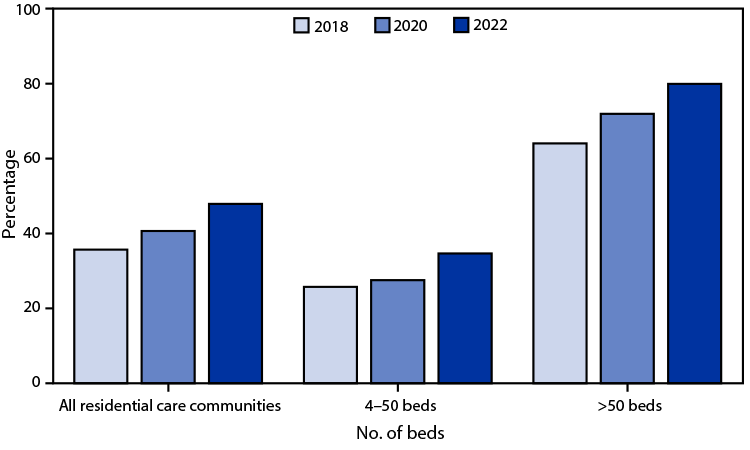QuickStats: Percentage of Residential Care Communities* That Use Electronic Health Records, by Community Bed Size — United States, 2018, 2020, and 2022†
Weekly / May 2, 2024 / 73(17);409
Altmetric:

* Residential care communities are state-regulated, have four or more beds, provide room and board with at least two meals per day, and are staffed to provide supervision and assistance with personal care and health-related services to adults who cannot live independently but do not require intensive nursing care.
† Residential care communities with missing data were excluded.
From 2018 to 2022, the percentage of residential care communities (RCCs) using electronic health records (EHRs) increased from 36% to 48%. Use of EHRs increased during this time regardless of RCC size, and larger RCCs were more likely to use EHRs compared with smaller RCCs.
Supplementary Table: https://stacks.cdc.gov/view/cdc/153378
Source: National Center for Health Statistics, National Post-acute and Long-term Care Study, 2018, 2020, and 2022 data. https://www.cdc.gov/nchs/npals/questionnaires.htm
Reported by: Christine Caffrey, PhD, ccaffrey@cdc.gov; Manisha Sengupta, PhD.
Suggested citation for this article: QuickStats: Percentage of Residential Care Communities That Use Electronic Health Records, by Community Bed Size — United States, 2018, 2020, and 2022. MMWR Morb Mortal Wkly Rep 2024;73:409. DOI: http://dx.doi.org/10.15585/mmwr.mm7317a6.
MMWR and Morbidity and Mortality Weekly Report are service marks of the U.S. Department of Health and Human Services.
Use of trade names and commercial sources is for identification only and does not imply endorsement by the U.S. Department of
Health and Human Services.
References to non-CDC sites on the Internet are
provided as a service to MMWR readers and do not constitute or imply
endorsement of these organizations or their programs by CDC or the U.S.
Department of Health and Human Services. CDC is not responsible for the content
of pages found at these sites. URL addresses listed in MMWR were current as of
the date of publication.
All HTML versions of MMWR articles are generated from final proofs through an automated process. This conversion might result in character translation or format errors in the HTML version. Users are referred to the electronic PDF version (https://www.cdc.gov/mmwr) and/or the original MMWR paper copy for printable versions of official text, figures, and tables.
Questions or messages regarding errors in formatting should be addressed to mmwrq@cdc.gov.

